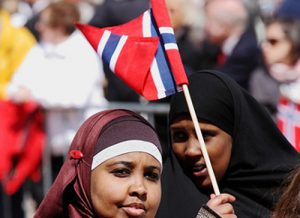
The Nordic Model, embodied by countries like Denmark, Sweden, Norway, Finland, and Iceland, is renowned for seamlessly blending robust social welfare with economic success (Kautto & Kuitto, 2021). At its heart lies a strong social safety net supported by robust tax structures. However, the influx of immigrants due to open economies and aging populations presents a challenge. This essay argues that managing immigration effectively can enhance the long-term sustainability of the Nordic Model.
One significant concern is the potential strain on social services due to increased immigration. According to a recent report by Statista (n.d.), there has been a steady rise in immigration, with over 180,000 immigrants settling in the region in 2022 alone. This surge could stretch public services such as healthcare and education, potentially surpassing existing capacities (Blau & Mackie, 2017). Additionally, heightened job competition, particularly in low-skilled sectors, might depress wages for both native and immigrant workers (Edo, 2015), which could, in turn, impact the tax base sustaining welfare programs.
Nonetheless, the Nordic Model’s influence on welfare extends beyond immediate challenges. The aging populations in Scandinavian nations, as reported by the OECD (2022), signify a gradual increase in the median age, with nearly 30% of individuals expected to be over 65 by 2050. This demographic shift results in a shrinking workforce and strains the tax base supporting social programs. Immigration offers a solution by providing a younger demographic capable of contributing to the labor force and replenishing the tax base (Rauhut et al., 2007). Interestingly, a Statista study indicates that immigrants in Nordic nations are usually of working age and have higher fertility rates compared to native-born populations (Statista, n.d.), which not only boosts the tax base but also fosters a more sustainable demographic balance over time. Furthermore, beyond demographic factors, immigration can also stimulate economic growth. Immigrants often bring valuable skills and expertise that address shortages in the labor market, especially in high-demand sectors such as technology and healthcare (Jakobsen et al., 2018). Additionally, immigrants can start businesses and contribute to innovation, enhancing economic vibrancy (Ensign & Robinson, 2011). According to research from the Centre for Economic Policy Research, immigration has a positive impact on GDP growth in Nordic countries (Johnson, 1980). This economic expansion, in turn, strengthens the tax base, providing further support to the social welfare system.

The effective integration of immigrants holds significant importance in ensuring that immigration bolsters the Nordic Model. Effective policies are essential to address concerns and promote social cohesion amidst immigration. Language training programs play a crucial role in providing immigrants with the necessary skills to fully participate in the workforce and society (Irastorza & Bevelander, 2021). Additionally, support in job placement helps immigrants secure employment that matches their skills and qualifications. Furthermore, initiatives that encourage cultural exchange and foster tolerance contribute to creating a more inclusive society (Pyrhönen, Leinonen, & Martikainen, 2017). By implementing these strategies, Nordic countries can mitigate potential challenges associated with immigration and facilitate a smooth integration process.
Although some argue that immigration might lead to job displacement among native-born workers, such worries are often overstated. Studies show that immigration has a minimal negative impact on overall employment rates and could even result in the creation of new job openings (Piyapromdee, 2020). Furthermore, the skills and experiences brought by immigrants can complement those of the native workforce, potentially boosting productivity and promoting economic growth.
In summary, the Nordic Model, seen in countries like Denmark, Sweden, Norway, Finland, and Iceland, effectively blends strong social welfare with economic success, thanks to its robust social safety net and tax system. Though immigration poses challenges like straining social services and potential job displacement, managing it well can strengthen the model’s future. This requires implementing policies like language training, job support, and cultural integration efforts. Additionally, immigration can boost economic growth and demographic balance, supporting the model’s sustainability. Despite concerns about job displacement, research suggests immigrants can complement the local workforce, driving productivity and economic growth. Ultimately, successfully integrating immigrants is crucial for maintaining the Nordic Model’s success, offering a model for inclusive economic
Author: Pulung Aruna Bhumi
Editor: Ariefah Amini, Debby Salsabila
References:
Blau, F. D., & Mackie, C. D. (2017). The economic and fiscal consequences of immigration. National Academies Press.
Edo, A. (2015). The impact of immigration on native wages and employment. The B.E. Journal of Economic Analysis & Policy, 15(3).https://doi.org/10.1515/bejeap-2014-0075
Ensign, P. C., & Robinson, N. P. (2011). Entrepreneurs because they are immigrants or immigrants because they are entrepreneurs? The Journal of Entrepreneurship, 20(1), 33–53. https://doi.org/10.1177/097135571002000102
Irastorza, N., & Bevelander, P. (2021). Skilled migrants in the swedish labour market: An analysis of employment, income and occupational status. Sustainability, 13(6), 3428. https://doi.org/10.3390/su13063428
Jakobsen, V., Korpi, T., & Lorentzen, T. (2018). Immigration and integration policy and labour market attainment among immigrants to Scandinavia. European Journal of Population, 35(2), 305–328. https://doi.org/10.1007/s10680-018-9483-3
Johnson, G. E. (1980). The labor market effects of immigration. Industrial and Labor Relations Review, 33(3), 331. https://doi.org/10.2307/2522570
Kautto, M., & Kuitto, K. (2021). The Nordic countries. The Oxford Handbook of the Welfare State, 802–825. https://doi.org/10.1093/oxfordhb/9780198828389.013.46
OECD. (n.d.). Ageing and demographic change – OECD. Www.oecd.org. https://www.oecd.org/economy/ageing-inclusive-growth/
Piyapromdee, S. (2020). The impact of immigration on wages, internal migration, and welfare. The Review of Economic Studies, 88(1).
https://doi.org/10.1093/restud/rdaa029
Statista. (n.d.-a). Emigration from Sweden from 2013 to 2023. Statista. https://www.statista.com/statistics/523321/sweden-emigration/
Statista. (n.d.-b). Number of immigrants in the Nordic countries from 2000 to 2022. Statista. https://www.statista.com/statistics/1296469/immigration-nordic-countries/




